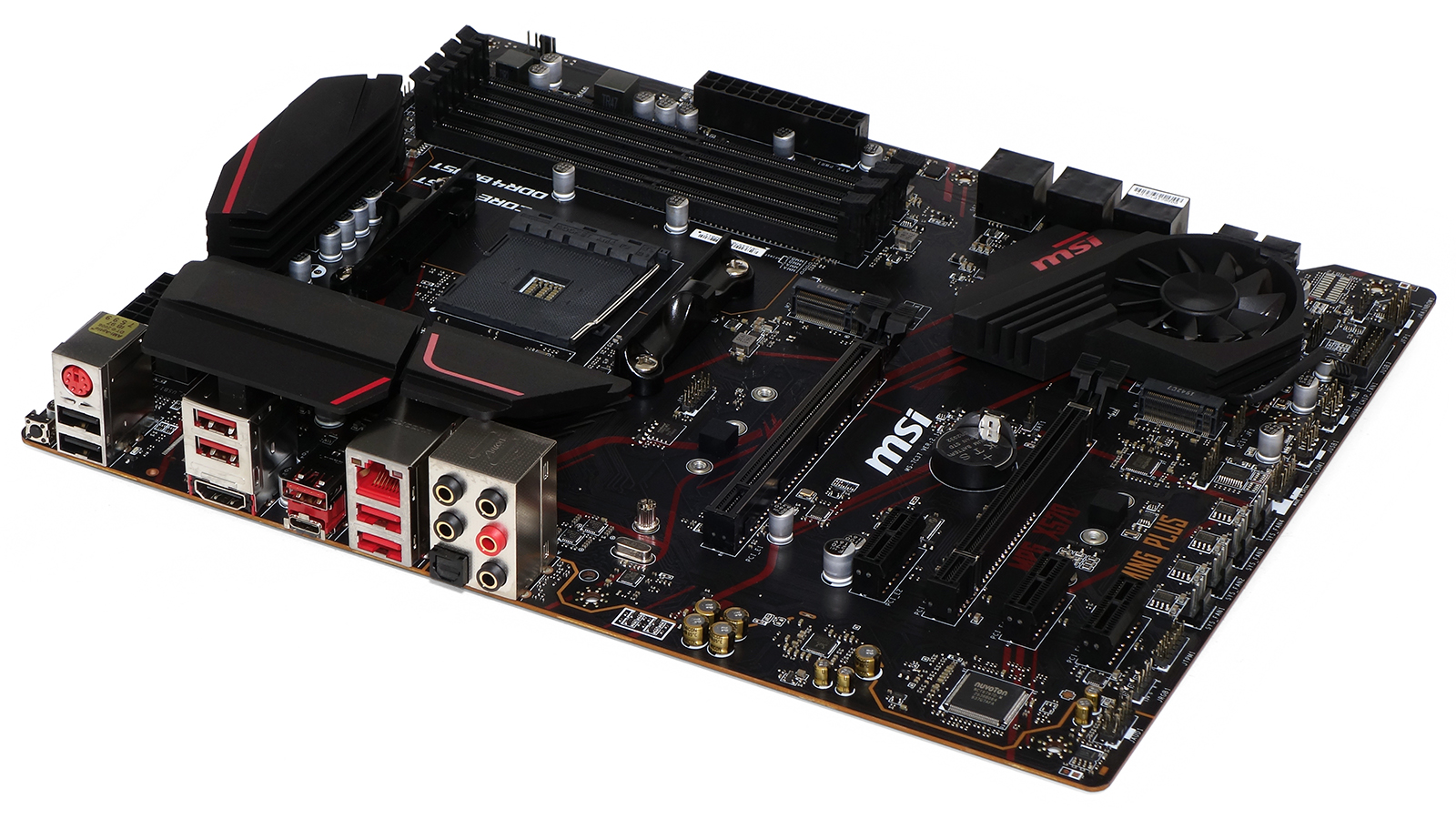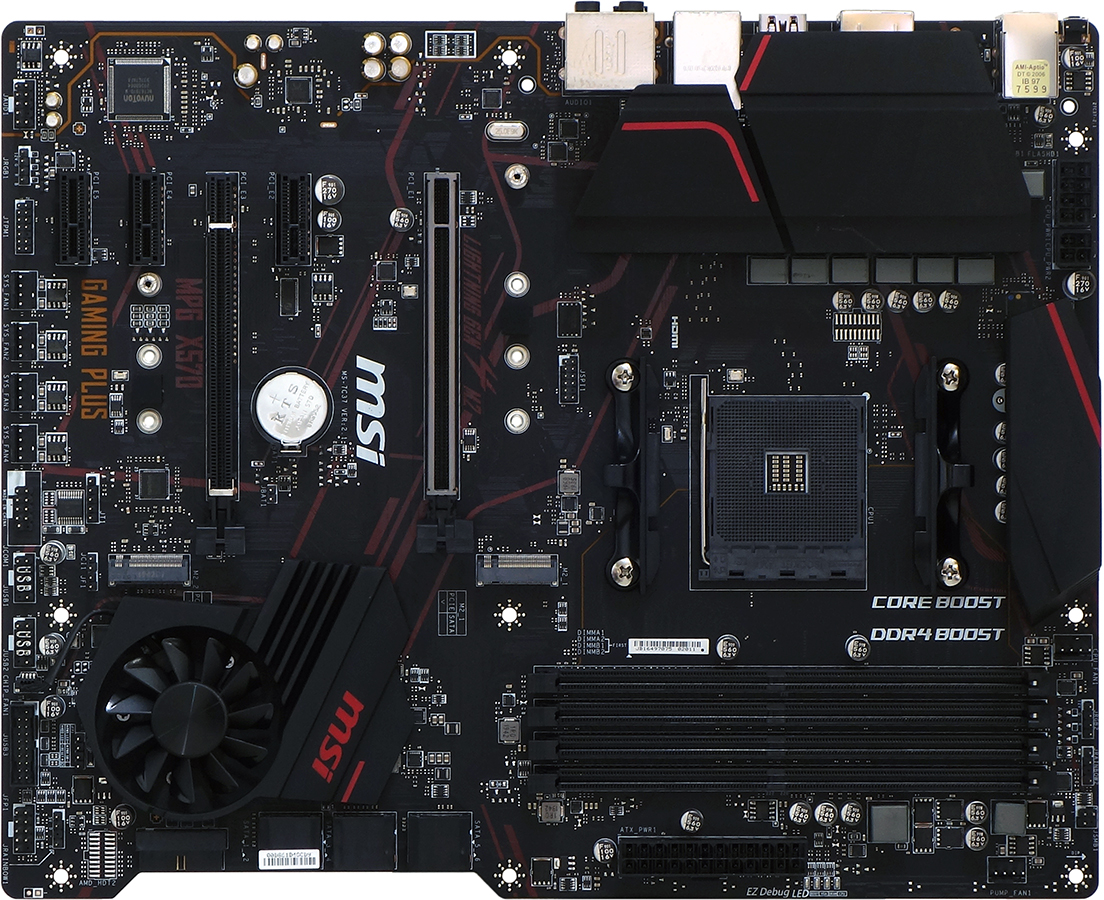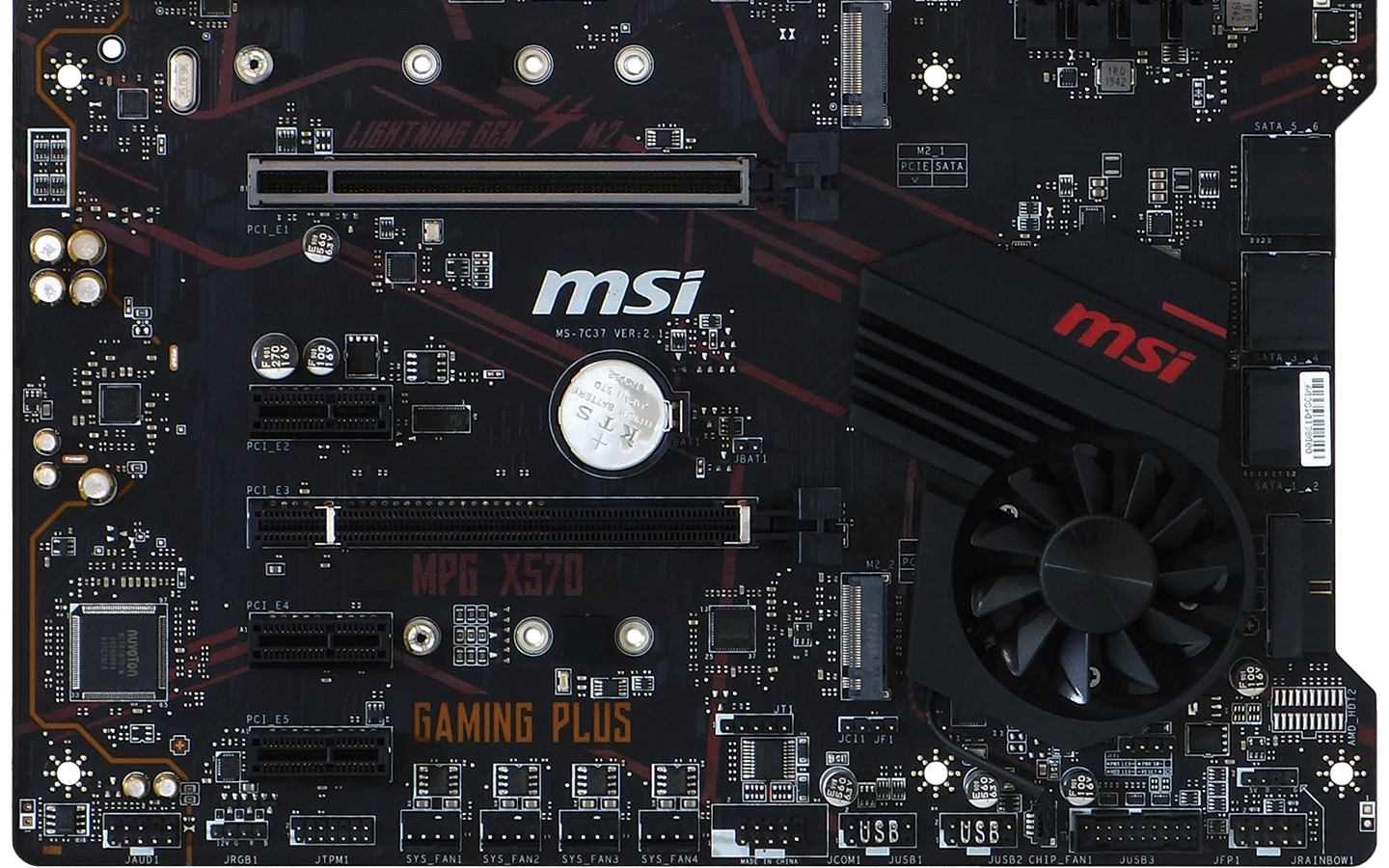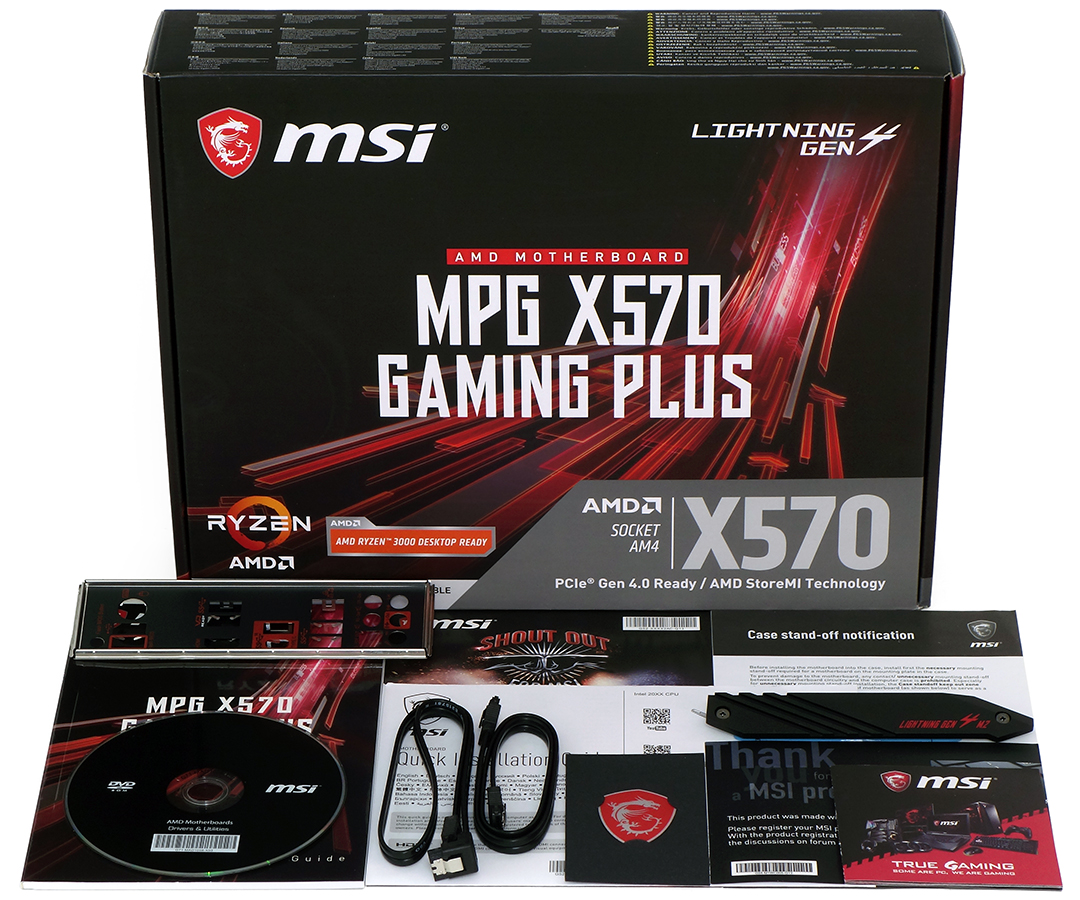Tom's Hardware Verdict
If motherboard sufficiency is all you need for your AMD Ryzen 3000 processor, the MPG X570 Gaming Plus gets you that -- and a bit more -- at an ultra-low price.
Pros
- +
Adequate voltage regulator for Ryzen 3000 range
- +
Good overclocking on mid-budget Ryzen 7 3700X
Cons
- -
Some software and BIOS features didn’t work for us
Why you can trust Tom's Hardware
A mere six months have passed since MSI told us that there would be no cheap X570 motherboards. But at just $160, MSI’s MPG X570 Gaming Plus certainly seems cheap. Or perhaps six months of higher prices have changed our perspective? We do remember a time when the cheapest boards to use an enthusiast-class chipset were priced around $120.
Regardless of how we define cheapness, this board still gets you a voltage regulator with eight 46A MOSFETs for the CPU core on a board that undercuts the other “value-priced models” we’ve tested by a wide margin. That voltage regulator should be adequate to run the full range of Ryzen 3000processors at stock settings. Since our test CPU is a middle model, we’ll push it a bit with overclocking.
Specifications
| Socket | AM4 |
| Chipset | AMD X570 |
| Form Factor | ATX |
| Voltage Regulator | 10 Phases (8+2) |
| Video Ports | HDMI 1.4 |
| USB Ports | 10Gbps: (1) Type-C, (1) Type A; 5Gb/s: (4) Type A; (2) USB 2.0 |
| Network Jacks | Gigabit Ethernet |
| Audio Jacks | (5) Analog, (1) Digital Out |
| Legacy Ports/Jacks | (1) PS/2 |
| Other Ports/Jack | BIOS Flash |
| PCIe x16 | (2) v4.0 (x16/x4) |
| PCIe x8 | ✗ |
| PCIe x4 | ✗ |
| PCIe x1 | (3) v4.0 (second excludes first) |
| CrossFire/SLI | 2x / ✗ |
| DIMM slots | (4) DDR4 |
| M.2 slots | (1) PCIe 4.0 x4, (2) PCIe 4.0 x4 / SATA |
| U.2 Ports | ✗ |
| SATA Ports | (6) 6Gb/s |
| USB Headers | (2) v3.x Gen1, (2) v2.0, |
| Fan Headers | Fan Headers |
| Legacy Interfaces | Serial COM Port, System (Beep-code) Speaker |
| Other Interfaces | FP-Audio, (2) RGB LED, TPM, (2) ARGB LED, Corsair LED, RGB LED |
| Diagnostics Panel | ✗ |
| Internal Button/Switch | ✗ / ✗ |
| SATA Controllers | ASM1061 PCIe 2.0 x1, Integrated (0/1/10) |
| Ethernet Controllers | RTL8111H PCIe |
| Wi-Fi / Bluetooth | ✗ |
| USB Controllers | ✗ |
| HD Audio Codec | ALC1220 |
| DDL/DTS Connect | ✗ |
| Warranty | 3 Years |
The MPG X570 Gaming Plus has very little going for it outside of the adequate-capacity voltage regulator, though it does a fair job with the basics. We still get PCIe 4.0 to all the board's slots, and the audio codec is the same ALC1220 we would expect to find on $200+ models. And that audio codec still feeds five rear-panel audio jacks and a front-panel HD Audio header, because there wouldn’t be much value to crippling it with cheaper connectors.

Zooming in, we also find a tiny button for flashing the firmware which, lacking the ASIC that allows certain pricier boards to update firmware without certain hardware, seems only a little out of place on a model this inexpensive. We also see a PS/2 port for legacy keyboards and mice, two USB 2.0 ports that we’ll assume are for contemporary keyboards and mice, four USB3 Gen 1 ports (5Gbps), Type A and Type-C Gen 2 ports (10Gbps), Gigabit Ethernet via a low-cost Realtek controller, and a digital optical audio output.

With four of the CPU’s PCIe 4.0 lanes going to an M.2 slot and four more to the X570 PCH as AMD intended, all sixteen remaining lanes go to the top PCIe slot in fixed fashion. You won’t be running SLI on this board, but you might be tempted to use the second x16-length slot to feed a second card in a CrossFire array, though that would be in x4 mode through the chipset.
The three x1 slots are even more limited: Not only do they compete with everything else on the chipset for bandwidth, but the top x1 slot gets disabled whenever a card is detected in the second x1 slot. And that automatic selection explains why we see only one PCIe pathway diverting switch on the entire board, behind the first PCIe x1 slot.

Users have told us (via Newegg reviews) that SATA ports 1 and 2 are to be avoided, as these are the two that are fed by the board’s PCIe 2.0 x1-to-SATA adapter. Ouch. While that part is listed in both the web specs and user manual, neither of those official sources would even tell us that much.
Get Tom's Hardware's best news and in-depth reviews, straight to your inbox.
Builders hoping to use the money saved here to splurge on a case might want to hold back a little, as the MPG X570 Gaming Plus has no Gen2 front-panel USB header. On the other hand, those retaining an old high-end case might appreciate that this board has two USB3 Gen1 front-panel headers.

The MPG X570 Gaming Plus’s bottom edge is lined with headers for front-panel audio, one (of two) RGB cables, TPM, four (of six) PWM fan headers, serial COM port, two dual-port USB 2.0, one (of two) dual-port USB 3.0, and an Intel-spec front-panel LED/button group. Above those are a factory (reserved) header, chassis intrusion, PC speaker/buzzer, and one (of two) ARGB headers. The other RGB and ARGB headers are located near the board’s upper-front corner.
Capable of supporting either PCIe/NVMe or SATA interfaced drives, the second M.2 header is to the left of the PCH fan.

The MPS X570 Gaming Plus includes a printed manual in the box, along with a snap-in I/O shield, driver/application disc, two SATA cables, a case badge, an M.2 heat spreader, quick installation guide, and several other pieces of documentation.
MORE: Best Motherboards
MORE: How To Choose A Motherboard
MORE: All Motherboard Content
-
tennis2 So even X570 ATX boards still to this day have more physical expansion slots than they can sufficiently feed natively. This is why mATX should be king.Reply -
Crashman Reply
A bunch of graphics cards have coolers that are more than two slots thick. And most boards keep the top slot space vacant to make more room around the CPU, so that the second card would go into the case's fifth or sixth slot.tennis2 said:So even X570 ATX boards still to this day have more physical expansion slots than they can sufficiently feed natively. This is why mATX should be king. -
InvalidError Reply
How many people do you know will actually need more than one 4.0x4 slot for M.2? Linus recently did a side-by-side SATA3 vs 3.0x4 vs 4.0x4 "blind test" in general use and SATA actually won - even people in the hardware review business cannot reliably tell the difference in real-world use other than file copy.tennis2 said:So even X570 ATX boards still to this day have more physical expansion slots than they can sufficiently feed natively. This is why mATX should be king.
For most people, the flexibility of being able to pick between interface A or B for a given group of HSIO lanes without having to pay an exorbitant price premium for extra IO to support everything at once is far more valuable and you cannot cram all of that flexibility on a mATX board. Especially when two or even three out of four PCIe slots may be blocked off my the GPU alone as Crashman mentioned.
I have a mATX board in my current PC and regret that decision since it means I cannot have both my USB3 and FireWire cards (yes, I still occasionally use some FW stuff) installed at the same time since I have only one usable slot aside from the GPU. -
tennis2 Even with a dual slot GPU, most mATX boards still have 2 empty PCIe slots. Except, unlike ATX where "if you use this slot, this one gets disabled" doesn't come into play since you don't have more slots than can be simultaneously fed.Reply
I'm not saying ATX shouldn't exist, there's just no reason it should be the most common form factor anymore with all the built in IO and features that modern chipsets have. Not like back in the day where you needed an add-in card for even fairly common IO tasks. -
2Be_or_Not2Be ReplyInvalidError said:I have a mATX board in my current PC and regret that decision since it means I cannot have both my USB3 and FireWire cards (yes, I still occasionally use some FW stuff) installed at the same time since I have only one usable slot aside from the GPU.
Wait, are you saying that you have a USB3 add-in card? I think you might need a new m/b, not more slots in that old one. ;)
Kidding aside, I do think that mfgs still make way too many full-size ATX and not enough micro-ATX/mini-ITX. I think multi-GPU setups have been waning in popularity, whether due to lack of return in cryptomining or just the overall higher expense of multiple high-end GPUs without a corresponding linear increase in performance. Yet we don't see more micro-ATX, ITX, or even DTX boards; we see the same large amount of ATX/eATX.
I personally only need a mini-ITX board (YMMV, of ocurse), and I would love to see more options available in that space. -
Crashman Reply
I already explained it to you. With the hardware these guys want, the second card has to go into the case's fifth or sixth slots. Now, you go tell the motherboard companies they can't push the top slot down into the second space. And while you're at it, tell the graphics card companies that all cards must be at most two spaces thick.tennis2 said:Even with a dual slot GPU, most mATX boards still have 2 empty PCIe slots. Except, unlike ATX where "if you use this slot, this one gets disabled" doesn't come into play since you don't have more slots than can be simultaneously fed.
I'm not saying ATX shouldn't exist, there's just no reason it should be the most common form factor anymore with all the built in IO and features that modern chipsets have. Not like back in the day where you needed an add-in card for even fairly common IO tasks.
I don't have to like it, I need only be realistic. -
InvalidError Reply
A new motherboard wouldn't help since most modern boards still only have six USB ports at the back. One of those would still get dedicated to my UPS, three of them would still go to my USB hubs for convenient access to USB ports (my computer is deep under my desk, so using front-panel ports is a non-option), mouse and keyboard fill in the rest.2Be_or_Not2Be said:Wait, are you saying that you have a USB3 add-in card? I think you might need a new m/b, not more slots in that old one. ;)
So, even if I upgraded my PC, chances are I'd still toss an USB3 card in for 2-4 extra ports so I can leave everything permanently wired in without daisy-chaining hubs. -
Ncogneto Replyadmin said:Our search for the best deal in 3rd Generation Ryzen processor support led us to MSI’s MPG X570 Gaming Plus. Is it a deal or should you look elsewhere for X570 options?
MSI MPG X570 Gaming Plus Review: Affordable Basics : Read more
Welcome to Tom's hardware, Were we stress test a motherboard with a 65w CPU.
Seriously?
"Most buyers in the sub-$200 motherboard market will never upgrade to the Ryzen 9 3950X, and few will even jump up to the 3900X, and hardly any buyers would expect boards in this price class to overclock those processors. When you’re mostly after the basics in an X570 board, so you can spend more on the processor or other components, the MPG X570 Gaming Plus is easy to recommend."
What kind of crap is that? Does it say on the box "does not support Ryzen 3900 or 3950x?
Tom's Hardware used to be a great place to go for good reviews. Now they are just pandering to there sponsors.
tsk tsk. -
Crashman Reply
Tom's Hardware used to be a great place to go for feedback. We tested this CPU up to 230W via overclocked stress tests. The 3950X TDP is 105W. Reading instead of skimming could be helpful..tsk tsk ;)Ncogneto said:Welcome to Tom's hardware, Were we stress test a motherboard with a 65w CPU.
Seriously?
"Most buyers in the sub-$200 motherboard market will never upgrade to the Ryzen 9 3950X, and few will even jump up to the 3900X, and hardly any buyers would expect boards in this price class to overclock those processors. When you’re mostly after the basics in an X570 board, so you can spend more on the processor or other components, the MPG X570 Gaming Plus is easy to recommend."
What kind of crap is that? Does it say on the box "does not support Ryzen 3900 or 3950x?
Tom's Hardware used to be a great place to go for good reviews. Now they are just pandering to there sponsors.
tsk tsk. -
Ncogneto Reply
"Most buyers in the sub-$200 motherboard market will never upgrade to the Ryzen 9 3950X, and few will even jump up to the 3900X, and hardly any buyers would expect boards in this price class to overclock those processors. When you’re mostly after the basics in an X570 board, so you can spend more on the processor or other components, the MPG X570 Gaming Plus is easy to recommend."Crashman said:Tom's Hardware used to be a great place to go for feedback. We tested this CPU up to 230W via overclocked stress tests. The 3950X TDP is 105W. Reading instead of skimming could be helpful..tsk tsk ;)
Seriously?
https://www.google.com/search?q=running+a+3900x+on+MSI+MPG+X570+Gaming+Plus&client=opera&hs=4IO&sxsrf=ALeKk00M7YkDWWnsoNBQbLEnqD3waTbylA:1582340287937&ei=v5hQXoHbOIy2swWp0JrQCA&start=10&sa=N&ved=2ahUKEwjBtpr2lOTnAhUM26wKHSmoBooQ8tMDegQIDBAz&biw=3440&bih=1368
_7PkZwY9PWMView: https://www.youtube.com/watch?v=_7PkZwY9PWM
_7PkZwY9PWM:672View: https://www.youtube.com/watch?v=_7PkZwY9PWM&t=672s
Has a bios revision corrected these problems? They have been duplicated on numerous other sites.
But seriously, how can you recommend this board when other boards do much better.......
